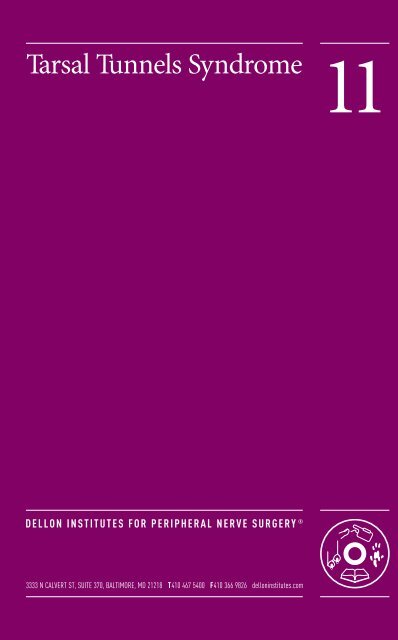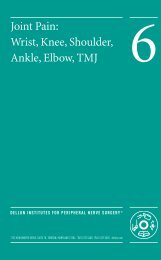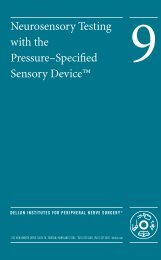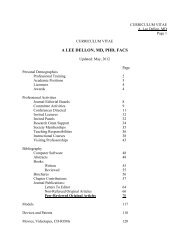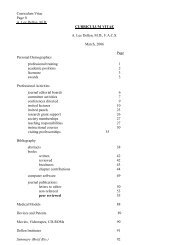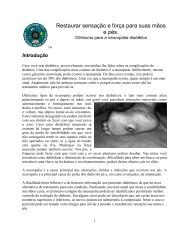Tarsal Tunnels Syndrome - Dellon Institutes for Peripheral Nerve ...
Tarsal Tunnels Syndrome - Dellon Institutes for Peripheral Nerve ...
Tarsal Tunnels Syndrome - Dellon Institutes for Peripheral Nerve ...
Create successful ePaper yourself
Turn your PDF publications into a flip-book with our unique Google optimized e-Paper software.
<strong>Tarsal</strong> <strong>Tunnels</strong> <strong>Syndrome</strong><br />
11<br />
DELLON INSTITUTES FOR PERIPHERAL NERVE SURGERY ®<br />
3333 N CALVERT ST, SUITE 370, BALTIMORE, MD 21218 T410 467 5400 F410 366 9826 delloninstitutes.com
your complaints are<br />
Numbness and tingling in the toes, ball of the foot, arch<br />
of the foot, or the heel.<br />
There may be cramping or curling of your toes.<br />
The complaints worsen during the day, worsen with<br />
work, and may keep you up at night.<br />
treatment without surgery<br />
See your medical doctor to be sure your feet are not<br />
swelling, or, if both feet are numb, to learn if you have a<br />
neuropathy that can be medically treated, like diabetes.<br />
(See the Neuropathy brochure <strong>for</strong> more in<strong>for</strong>mation.)<br />
See your foot doctor to learn if you need shoe inserts<br />
(orthotics) to keep your foot from rolling too much to<br />
one side or the other (either pronating or supinating).<br />
what causes your complaints?<br />
At the inside of your ankle, a nerve divides into<br />
branches, and crosses from the leg into the foot through<br />
a series of tunnels.<br />
This nerve is called the Tibial <strong>Nerve</strong>, and it branches<br />
the medial and lateral plantar,and the<br />
calcaneal nerves.<br />
The nerve is the thickness of a pen.<br />
Modify your daily walking or exercising activities.<br />
when should i have surgery?<br />
When your feet or toes are numb most of the day.<br />
When your foot or feet disturb your sleep every night.<br />
When you have trouble feeling the floor, or the car gas<br />
or break pedals.<br />
When the ankle moves, the nerve gets pressed.<br />
When you begin to lose your balance.<br />
When the nerve gets pressed, blood flow to the nerve<br />
slows, blood flow decreases, and the nerve sends a<br />
message of numbness and tingling, or buzzing of the<br />
foot/toes.<br />
When there is pain associated with the numbness.<br />
When neurosensory testing with the Pressure-Specified<br />
Sensory Device (see the Neurosensory Testing brochure<br />
<strong>for</strong> more in<strong>for</strong>mation) demonstrates that sensory nerves<br />
to your big toe pulp or heel are degenerating.<br />
TOLL FREE 877-DELLON-1<br />
TARSAL TUNNELS SYNDROME<br />
DELLON INSTITUTES FOR PERIPHERAL NERVE SURGERY ®<br />
DELLONINSTITUTES.COM
what is the surgery like?<br />
The surgery takes about one and one-half hours.<br />
The surgery is per<strong>for</strong>med as an outpatient.<br />
The surgery is per<strong>for</strong>med with general anesthesia.<br />
An incision is made about four inches long, inside<br />
the ankle.<br />
surgery on the tarsal tunnels<br />
The steps in decompression<br />
of the four<br />
medial ankle tunnels<br />
<strong>for</strong> treatment of tarsal<br />
tunnels syndrome.<br />
A. <strong>Tarsal</strong> tunnel<br />
is opened.<br />
The tibial nerve is identified by releasing the thin ligament<br />
<strong>for</strong>ming the roof of the tarsal tunnel. The<br />
branching pattern of the tibial nerve is then identified.<br />
Each of the three main branches of the tibial nerve has<br />
its own fibrous tunnel that must then be released.<br />
Scarring within the nerves in each tunnel can then be<br />
removed with microsurgery (internal neurolysis).<br />
B. Roof of medial<br />
plantar tunnel is open.<br />
C. Roof of lateral<br />
plantar tunnel is open.<br />
D. Septum between<br />
tunnels is divided and<br />
calcaneal tunnel<br />
is opened.<br />
Local anesthesia is placed into the skin, so the toes and<br />
bottom of the foot may be numb <strong>for</strong> a few hours, but<br />
there will be little pain after the surgery.<br />
A large cotton bandage is put on your foot. You can<br />
walk using a walker immediately after surgery.<br />
E. Septum is removed<br />
to create a large<br />
tunnel, completing<br />
decompression of the<br />
tarsal tunnels.<br />
This bandage is removed after one week. You will<br />
continue using a walker <strong>for</strong> three weeks, which is when<br />
the sutures are removed.<br />
TOLL FREE 877-DELLON-1<br />
TARSAL TUNNELS SYNDROME<br />
DELLON INSTITUTES FOR PERIPHERAL NERVE SURGERY ®<br />
DELLONINSTITUTES.COM
CALL TOLL FREE<br />
877-DELLON-1<br />
to find the location<br />
of the nearest<br />
<strong>Dellon</strong> Institute<br />
what are the risks of surgery?<br />
The published outcomes of the <strong>Dellon</strong>-approach to the<br />
treatment of tarsal tunnels syndrome offer the best<br />
chance <strong>for</strong> success <strong>for</strong> relief of your symptoms. There are<br />
risks associated with every surgical procedure, such as<br />
the risk of anesthesia, bleeding and infection. Complications<br />
unique to decompression of the four medial ankle<br />
tunnels are:<br />
being academic in private practice sm<br />
Mackinnon SE, <strong>Dellon</strong> AL: Homologies between the tarsal and carpal<br />
tunnels: Implications <strong>for</strong> treatment of the tarsal tunnel syndrome.<br />
Contemp Orthop 14:75-79, 1987.<br />
Mackinnon, S.E., <strong>Dellon</strong>, A.L.: <strong>Tarsal</strong> Tunnel <strong>Syndrome</strong>, Surgery of the<br />
<strong>Peripheral</strong> <strong>Nerve</strong>, Chapter 12, Thieme Pub., New York, NY., 1988.<br />
Tassler PL, <strong>Dellon</strong> AL: Pressure perception in the normal lower extremity<br />
and in tarsal tunnel syndrome. Muscle <strong>Nerve</strong> 19:285-289, 1996.<br />
BROCHURES<br />
IN THIS SERIES:<br />
Carpal Tunnel<br />
<strong>Syndrome</strong><br />
Cubital Tunnel<br />
<strong>Syndrome</strong><br />
Foot Drop<br />
Unpredictable nature of the healing process<br />
(scar <strong>for</strong>mation).<br />
Painful scar due to entrapment of a nerve to the skin.<br />
Walking after surgery can cause sutures to break.<br />
Wound healing can take longer if you are a diabetic.<br />
There may be remaining numbness in the toes or heel.<br />
<strong>Nerve</strong> regeneration can be painful.<br />
It may take up to one year to achieve maximum relief.<br />
who should do this surgery?<br />
Surgeons from the <strong>Dellon</strong> <strong>Institutes</strong> <strong>for</strong> <strong>Peripheral</strong><br />
<strong>Nerve</strong> Surgery® have the most advanced training<br />
and experience doing this surgery, which offers you<br />
the best chance <strong>for</strong> success.<br />
<strong>Dellon</strong> AL: Computer-assisted sensibility evaluation and surgical treatment<br />
of tarsal tunnel syndrome. Adv Pod 2:17-40, 1996.<br />
Kim J, <strong>Dellon</strong> AL: <strong>Tarsal</strong> tunnel incisional pain due to neuroma of the<br />
posterior branch of saphenous nerve. J Amer Pod Med Assn, 91: 109-113,<br />
2001.<br />
<strong>Dellon</strong> AL, Kim J, Spaulding CM: Variations in the origin of the medial<br />
calcaneal nerve. J Amer Pod Med Assoc, Vol. 92, pp. 97-101, 2002.<br />
Aszmann OC, Tassler PL, <strong>Dellon</strong> AL: Changing the natural history of<br />
diabetic neuropathy: Incidence of ulcer/amputation in the contralateral<br />
limb of patients with a unilateral nerve decompression procedure, Ann<br />
Plast Surg, 53:517-522, 2004.<br />
Lee C, <strong>Dellon</strong> AL: Prognostic ability of Tinel sign in determining<br />
outcome <strong>for</strong> decompression surgery decompression surgery in diabetic<br />
and non-diabetic neuropathy, Ann Plast Surg, 53:523-27, 2004.<br />
Groin Pain<br />
Heel Pain<br />
Joint Pain<br />
<strong>Nerve</strong> Injury and<br />
Repair<br />
Neuropathy<br />
Neurosensory<br />
Testing With<br />
The Pressure-Specified<br />
Sensory Device<br />
Radial <strong>Nerve</strong><br />
Entrapments<br />
<strong>Tarsal</strong> <strong>Tunnels</strong><br />
<strong>Syndrome</strong><br />
Thoracic Outlet<br />
<strong>Syndrome</strong><br />
TOLL FREE 877-DELLON-1<br />
TARSAL TUNNELS SYNDROME<br />
DELLON INSTITUTES FOR PERIPHERAL NERVE SURGERY ®<br />
DELLONINSTITUTES.COM
delloninstitutes.com<br />
call toll free<br />
877-dellon-1<br />
877-335-5661<br />
DELLON INSTITUTES FOR PERIPHERAL NERVE SURGERY ®<br />
3333 N CALVERT ST, SUITE 370, BALTIMORE, MD 21218 T410 467 5400 F410 366 9826 delloninstitutes.com


